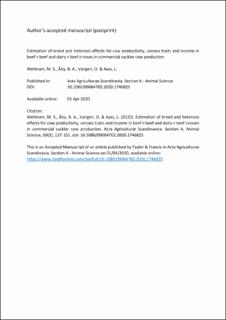Estimation of breed and heterosis effects for cow productivity, carcass traits and income in beef × beef and dairy × beef crosses in commercial suckler cow production
Peer reviewed, Journal article
Accepted version
Permanent lenke
https://hdl.handle.net/11250/2686701Utgivelsesdato
2020Metadata
Vis full innførselSamlinger
Originalversjon
Wetlesen, M. S., Åby, B. A., Vangen, O. & Aass, L. (2020). Estimation of breed and heterosis effects for cow productivity, carcass traits and income in beef × beef and dairy × beef crosses in commercial suckler cow production. Acta Agriculturæ Scandinavica. Section A, Animal Science, 69(3), 137-151. doi: 10.1080/09064702.2020.1746825Sammendrag
This study aims to investigate calving difficulties, birth-, weaning- and carcass weight, herd life of cow, age at slaughter, average daily carcass gain, carcass conformation, carcass fatness and carcass income per carcass, kg or day, in Aberdeen Angus (A), Hereford (H), Charolais (C), Limousin (L), Simmental (S), Norwegian red (N) and their crosses, in order to evaluate crossbreeding strategies. Direct and maternal breed additive and heterosis effects and predicted phenotypic means were estimated with multiple regression using SAS. Crosses with N resulted in higher weaning weight and less calving difficulties than beef purebreds. Due to favourable maternal additive effects of N on carcass weight and -income, crosses with British breeds had higher performance than the purebreds. (A × C) × C had overall high performance due to beneficial maternal heterosis effects on calving difficulties and carcass weight. In conclusion, utilising profitable heterosis effects have potential in commercial production, but are dependent on production systems.
